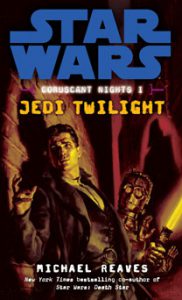If you’re following the EU in chronological order, Michael Reaves’ “Coruscant Nights I: Jedi Twilight” (2008) is an oddity for a couple reasons. First, rather than trying to track down Obi-Wan and Yoda, as one might expect, Vader becomes obsessed with finding Jax Pavan. This feels like equal parts “inexplicable shift in the plotline” and “compelling mystery for the rest of the trilogy.” Secondly, we witness the death of Even Piell, who is already dead at this point, as per “The Clone Wars.” This has a real-world explanation (more on that later), but no fictional answer.
Already a veteran “Star Wars” author at this point from the “Droids” cartoons and four novels, Reaves’ prose flows nicely – and he has cut back on the use of too-cute “Star Wars” phrases like “heavy isotope” as the equivalent of heavy metal music. The events of his novels don’t stick with me as much as those of elite writers like Stackpole, Traviss, Allston and Zahn, but on a paragraph-by-paragraph basis, he’s one of the most enjoyable to read – and perhaps the most underrated.
One element that gives some readers pause is that Reaves focuses on his own characters’ points of view without explaining why we should care. This isn’t a problem in the long run, because we learn to like the ragtag groups of misfits he throws together. But it is jarring at first. Who is this Jax Pavan, other than a random Jedi who happens to be the son of another random Jedi, Lorn Pavan, from “Darth Maul: Shadow Hunter?” Well, he’s being targeted by Vader, so there must be something to him, although that mystery is deferred for now.
We know Jax considered Anakin to be a friend, but since we never saw them interact in any previous story – indeed, “Jedi Twilight” marks his first appearance – in my head I imagine that they were colleagues who would politely nod at each other in the halls of the Temple. Maybe they’d spar together on occasion. I hope for detailed flashbacks in upcoming books. Or maybe Vader is tracking Pavan for the same reason he was tracking Shryne in “Dark Lord” and various Force-users in the “Purge” and “Darth Vader” comics – because he happened to pick up his scent.
In “Jedi Twilight,” Jax does little to stand out from other Force-users-on-the-run, who include Das Jennir from “Dark Times” and who are the template for Disney’s Kanan and Ezra on “Rebels.” He’s surly after months of living in the slums of the underlevels rather than in the posh Temple, and even though he’s done good work setting up the Underground Railroad-esque Whiplash, he’s irked that his ability to touch the Force waxes and wanes. I like the theory he comes up with on page 315: Because shielding himself from Vader had become second nature, now he can’t tap into the Force when he needs to.

As in the “MedStar” books (which Reaves co-wrote with Steve Perry), this is an ensemble piece. The Twi’lek Laranth is a Gray Paladin – a Force-user who prefers blasters to lightsabers. This is a great concept that seems to be pulled from another story, but actually, Reaves invents it here; more exploration of this warrior culture would be appreciated in future books. She’s also a possible love interest for Jax only in the sense that she’s the only female in the group.
The Sullustan Den Dhur and the sentient protocol droid I-Five are a comic-relief duo, with Den always scared and I-Five always heroic, to the annoyance of Jax, who scoffs at the idea that Lorn considered I-Five a friend. This continues a “Star Wars” theme that dates back to Alan Dean Foster’s novelization in 1976, but it’s most intensely explored in “Coruscant Nights,” as everyone – including the droid himself – mulls over whether I-Five’s life has equal value to organics.
An oddity of Jax’s biography is something that’s no fault of Reaves: Jax’s master, Even Piell, is killed off twice. Three years after this book’s publication, but a couple years earlier on the timeline, Piell dies in the “Clone Wars” Season 3 episode “Citadel Rescue.” Like the reinvention of Mandalore in Season 2 that clashed with Karen Traviss’ books, Piell’s biography was never retconned by the continuity gurus at LucasBooks. In a way, those two “Clone Wars” rewrites paved the way for Disney’s rebooting of the timeline in 2014. Back in the prequel era, the continuity folks would try to retcon things – for example, Jaster Mereel wasn’t Boba Fett, but he was a Mandalorian friend of Jango’s, thus explaining why Boba would use the name as an alias. A couple years into “The Clone Wars,” they had mostly given up – although Pablo Hidalgo took one last stab at retconning the Clone Wars timeline in “The Essential Reader’s Companion” (2012).
I also find it somewhat surprising that Vader has an Elomin assistant, Rhinann, who seems to have gotten the job in the same way you’d apply for any job. In the early days of Palpatine’s reign, aliens still served the Empire, but Palpatine gradually phased them out (see Sly Moore and Mas Amedda). Rhinann – who escapes and joins our heroes at book’s end – is there to provide a point-of-view character for how scary Vader is. But it’s always strange when side characters have close relationships to main characters, but only for one book.
That’s not to say Reaves disrespects other authors’ works by any means. “Jedi Twilight” lays some groundwork for the Vader-Xizor rivalry of Perry’s “Shadows of the Empire.” Both are pursuing a droid named Bug-Eyes who – in a maguffin we’re familiar with from “Shadow Hunter” and “A New Hope” — is supposedly carrying important data that could compromise the Empire (although at the end we find out that Vader invented the story in order to draw out Pavan). Reaves also checks in with Nick Rostu from Matthew Stover’s “Shatterpoint,” and he brings back Kaird, a bird-like alien who can disguise himself as other alien species, from his own “MedStar” books to serve as a rival to Xizor within the Black Sun ranks.
Picking up from “Shadow Hunter,” Reaves again delivers some of the best “mean streets of Coruscant” writing (that’s the conceit of this trilogy, after all) when the action comes to a head in an abandoned industrial area of the city-planet now ruled by feral droids and peppered with dangerous nuclear reactors.
Reaves’ writing has the strange quality of being easily readable yet ephemeral, because not much of galactic importance happens. Still, the banter of this gang of outcasts, the engaging geographic and architectural descriptions, and the mystery of why Vader is obsessed with Pavan are enough to have me reaching for the next entry.

